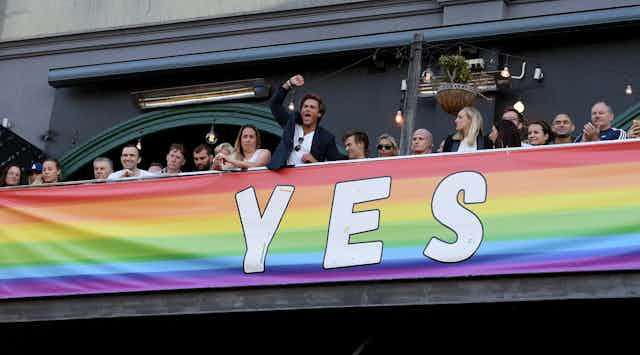Internet speed and download potential is what commonly comes to mind when we think of data. But Australia has recently been talking a different kind of data: statistics.
Australia has never seen the likes of the same-sex marriage survey. And the process gave us a crash course in using data to inform change.
Read more: What the numbers say (and don't say) in the same-sex marriage survey
From conception, mail out and mail back, to results (and the mishaps and misadventures of mailing paper forms to more than 16 million eligible Australians), this speedy application and immediacy of change informed by survey data is unprecedented on this scale in Australia.
And it is Australians’ unfamiliarity with a survey directly affecting legislation which might help us understand some of the results observed in socially conservative areas.
Data for change
Australians are no strangers to handing over data about ourselves. From brands of shampoo we use, television programs we watch, store loyalty benefits, to personal income, we do not seem to mind sharing our opinions and information.
The 2016 census saw a departure from this, as we collectively grappled with the idea of what it is to live in an increasingly digital environment. Fears over privacy and security of personal information collected in the census resulted in debates about the collection and holding of data.
Data is all around us. We make decisions drawing on data in our everyday lives based on our experiences. Knowing the best time to commute to work to avoid traffic, the softest or strongest toilet paper, reliable car brands; these are just a few examples.
But rarely do we see the real impact of surveys on our lives (to the disappointment of many researchers). When it comes to applying data derived by researchers, some people are wary, distrustful, afraid of data. Even when collected by experts.
Read more: Australians' attitudes to vaccination are more complex than a simple 'pro' or 'anti' label
Climate change and vaccination debates offer examples of how scepticism of experts and data collection lead to people drawing on their own anecdotal experiences for evidence. Our lived experiences form much of our opinions and attitudes.
An optional, non-binding survey
Most Australians (80%) took on the responsibility of creating social change through data when asked to respond to the single question about marriage law reform.
Participating in a survey, unlike a plebiscite or referendum, is optional. And, the result is non-binding (as is also the case in a plebiscite).
Participation in voluntary surveys is influenced by complex factors including personal motivation and attitudes. The marriage survey sought opinions on change, a change for some which meant internal grappling with social norms, traditional beliefs and religion.
This is in stark contrast to the comparatively mundane procedural changes stemming from Australian referendums (with the exception of the social impacts of the 1967 referendum).
For many, marriage and family is a vital aspect of community, and change may have been perceived as threatening to a way of being. This may have been burdensome for some Australians as they made decisions about how to respond to the same-sex marriage survey.
Read more: Same-sex marriage survey by the stats: a resounding 'yes' but western Sydney leads 'no' vote
Unlike our experiences with voting procedures (for example, small incremental change rather than major reform to avoid electorate backlash), we have received strong indication the marriage survey will likely lead to legislative change in a matter of weeks.
The Australian Bureau of Statistics — commonly tasked with counting people, sheep and cars (among other things) — redeemed itself after the Census mishaps of 2016 to show the impact of quality statistics and research processes to inform and make change.
What Australians want
We can feel a sense of ownership over the marriage law survey results, but actually they told us something we already knew.
Published in August 2017, representative sample survey data from the Household, Income and Labour Dynamics in Australia (HILDA) survey pointed to the outcome Australians wanted: marriage equality.
The postal ballot put the LGBTIQ community and their families through difficult times, with homophobic and violent actions reported. The results have also lead to some towns being been called out for their opposing views and assumptions made about the people that live there.
Read more: Science is important but moves too fast: five charts on how Australians view science and scientists
The same-sex marriage process has certainly shown that in a climate of fake news, it pays to know data. Participative democracy has reflected what Australians want, but there are important lessons to learn from the same-sex marriage survey. Whole-of-nation polling is best left to matters not as emotionally and socially charged as marriage equality.
In the end, the data shows we did not need a million-dollar nationwide survey of all Australians to confirm what social researchers knew.
The same-sex marriage postal vote results show us that sample surveys are powerful in telling us much about who we are and what we want as a nation.

